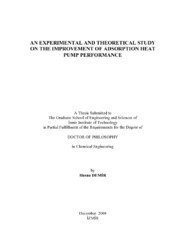Please use this identifier to cite or link to this item:
https://hdl.handle.net/11147/2986Full metadata record
| DC Field | Value | Language |
|---|---|---|
| dc.contributor.advisor | Ülkü, Semra | en |
| dc.contributor.author | Demir, Hasan | - |
| dc.date.accessioned | 2014-07-22T13:48:42Z | - |
| dc.date.available | 2014-07-22T13:48:42Z | - |
| dc.date.issued | 2008 | en |
| dc.identifier.uri | http://hdl.handle.net/11147/2986 | - |
| dc.description | Thesis (Doctoral)--Izmir Institute of Technology, Chemical Engineering, Izmir, 2008 | en |
| dc.description | Includes bibliographical references (leaves: 134-144) | en |
| dc.description | Text in English; Abstract: Turkish and English | en |
| dc.description | xviii, 177 leaves | en |
| dc.description.abstract | Adsorption heat pumps, which have considerably sparked attentions in recent years, have the advantage of being environmentally friendly and operating with heat sources such as waste heat, solar and geothermal energies as well as storing the energy.The present investigation covers working principle of adsorption heat pumps, a detailed literature survey on the performed studies, information about adsorption phenomena, experimental results of two differently designed and constructed systems, numerical simulation of heat and mass transfer in an annular adsorbent bed, and microcalorimetric study for obtaining isosteric heat of adsorption for water vapor-silica gel pair. The two intermittent adsorption heat pumps can operate without any leakage. The silica gelwater was employed as the adsorbent-adsorbate pair in both of the systems. The temperature and pressure in the evaporator, condenser and adsorbent bed were measured and the coefficients of performance, total entropy generation, the second law efficiency, specific heating and cooling power values were calculated based on these measured values for all of the representative cycles. The heat transfer area of the second designed adsorption heat pump is 550% greater than the first designed adsorption heat pump and this increase resulted in 170% and 200% of improvements in specific heating power (SHP) and specific cooling power (SCP) values respectively. The silica gel granules were mixed with small size metal pieces in order to accelerate heat transfer in the bed. Experiments were performed to measure the thermal diffusivity through the adsorbent bed in which adsorbent is mixed with metal pieces. It was observed that the mixing of silica gel grains with 10wt% of small size aluminum pieces increases the SHP and SCP values of the second heat pump by 250%. | en |
| dc.language.iso | en | en_US |
| dc.publisher | Izmir Institute of Technology | en_US |
| dc.rights | info:eu-repo/semantics/openAccess | en_US |
| dc.subject.lcc | TJ262. D378 2008 | en |
| dc.subject.lcsh | Heat pumps | en |
| dc.subject.lcsh | Adsorption | en |
| dc.subject.lcsh | Heat of adsorption | en |
| dc.title | An experimental and theoretical study on the improvement of adsorption heat pump performance | en_US |
| dc.type | Doctoral Thesis | en_US |
| dc.institutionauthor | Demir, Hasan | - |
| dc.department | Thesis (Doctoral)--İzmir Institute of Technology, Chemical Engineering | en_US |
| dc.relation.publicationcategory | Tez | en_US |
| item.languageiso639-1 | en | - |
| item.fulltext | With Fulltext | - |
| item.openairecristype | http://purl.org/coar/resource_type/c_18cf | - |
| item.openairetype | Doctoral Thesis | - |
| item.grantfulltext | open | - |
| item.cerifentitytype | Publications | - |
| crisitem.author.dept | 03.02. Department of Chemical Engineering | - |
| Appears in Collections: | Phd Degree / Doktora | |
Files in This Item:
| File | Description | Size | Format | |
|---|---|---|---|---|
| T000760.pdf | DoctoralThesis | 4.26 MB | Adobe PDF |  View/Open |
CORE Recommender
Page view(s)
172
checked on Jul 22, 2024
Download(s)
118
checked on Jul 22, 2024
Google ScholarTM
Check
Items in GCRIS Repository are protected by copyright, with all rights reserved, unless otherwise indicated.